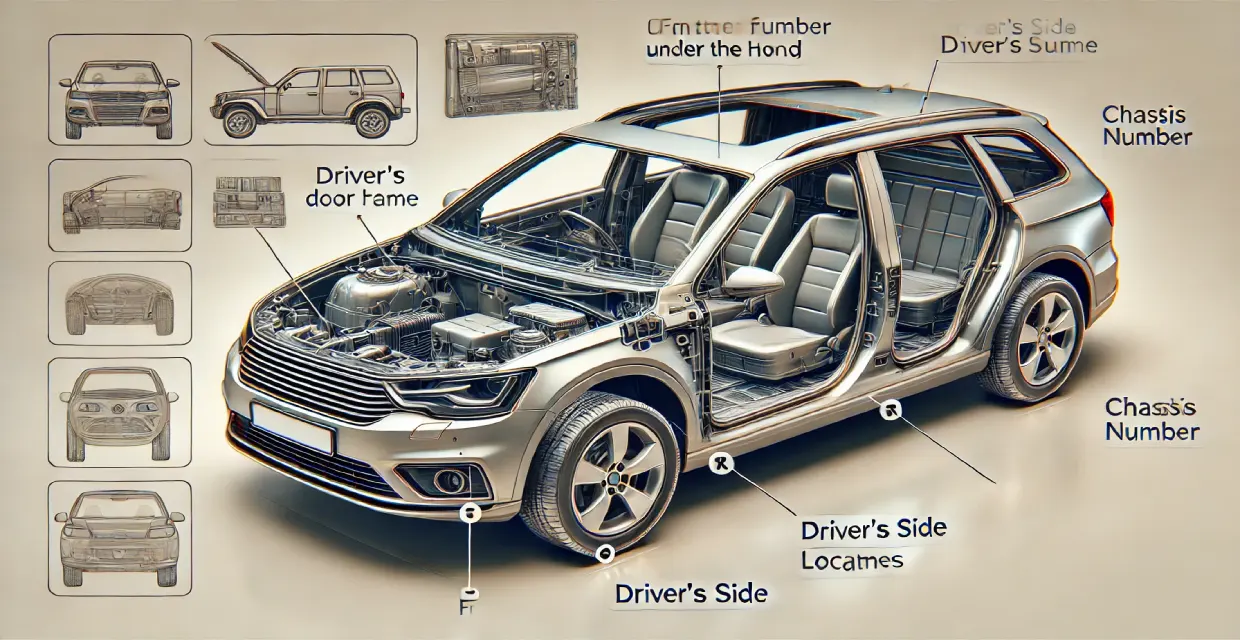

The chassis number, also known as the Vehicle Identification Number (VIN), is a unique identifier for every vehicle, containing vital information about the car's make, model, and production year. Understanding how to find the chassis number in cars is crucial for various reasons, including vehicle registration, insurance, and maintenance. This guide will help you locate the chassis number in different parts of your car and explain why it's essential.
The chassis number is more than just a random set of characters; it provides a wealth of information about your vehicle:
Manufacturer Information: Identifies the car maker.
Vehicle Description: Details about the model, body type, and engine type.
Production Information: Indicates the year of manufacture and the production sequence.
The chassis number can be found in several locations on a car. Here are the most common spots:
One of the most accessible places to find the chassis number is on the dashboard, visible through the windshield.
Steps:
Stand outside: Position yourself on the driver’s side of the car.
Look through the windshield: Focus on the area where the dashboard meets the windshield.
Find the VIN plate: You should see a metal plate or a sticker with the VIN inscribed on it.
This location is designed for quick access, especially useful during traffic stops or inspections.
Also Read:- How to Find VIN Number in Car
The VIN can often be found inside the driver’s side door.
Steps:
Open the driver’s door: This exposes the door frame.
Check the door frame or pillar: Look for a sticker or metal plate.
Locate the VIN: The VIN is usually printed or engraved here.
This spot is easy to access and check, often during routine maintenance or checks.
Also Read:- List of ADAS Cars in India
For many cars, particularly older models, the VIN can be found under the hood.
Steps:
Open the car’s hood: Safely prop it up.
Inspect the engine bay: Look at the front of the engine block or near it.
Find the VIN plate: It might be stamped onto the metal or attached to a plate.
This location is beneficial for detailed vehicle inspections and repairs.
Some cars have the VIN located inside the boot (trunk) area.
Steps:
Open the boot: Lift the spare tyre cover if present.
Inspect the rear or floor of the boot: Look for a stamped VIN or a metal plate.
Locate the VIN: The VIN should be easily visible.
This spot is typically used for additional verification.
Also Read:- 9 Seater Cars in India
The VIN is also listed on various vehicle-related documents, such as:
Registration Certificate: The VIN is printed on the vehicle registration document.
Insurance Papers: Your car insurance documents will include the VIN.
Owner’s Manual: The car’s owner’s manual often contains the VIN.
These documents are essential for legal and administrative purposes and are often required for registration, insurance claims, and resale.
Some car manufacturers provide an online tool to find the VIN using the car's registration number.
Steps:
Visit the manufacturer’s website: Navigate to the VIN lookup section.
Enter the registration number: Provide the necessary details.
Retrieve the VIN: The website will display the VIN based on the provided information.
Also Read:- Biggest Car Companies in India
Use a flashlight: Some VIN locations can be hard to see, especially in low light conditions.
Clean the area: If the VIN is dirty or obscured, gently clean it to make it visible.
Refer to the owner’s manual: The manual often has specific information about the VIN's location.
Understanding how to find the chassis number in a car and where the chassis number is in a car is essential for various reasons:
Registration and Legal Documentation: The VIN is crucial for vehicle registration, legal ownership transfers, and other official documentation. It uniquely identifies your vehicle, ensuring it is accurately recorded in governmental and legal databases.
Insurance: Insurance companies require the VIN for policy creation and claims processing. It helps in verifying the vehicle's details and ensuring accurate insurance coverage.
Service Records: The VIN is used by service centers to maintain accurate records of all maintenance and repairs performed on your vehicle. This is particularly useful for tracking the vehicle's history and ensuring proper upkeep.
Theft Recovery: In case of theft, the VIN is critical for identifying and recovering stolen vehicles. Law enforcement agencies use the VIN to track and identify vehicles, increasing the chances of recovery.
Also Read:- Paddle Shifter Cars in India
Knowing how to find the chassis number and where the chassis number is in a car is a fundamental aspect of vehicle ownership. Typically found on the dashboard, driver’s side door, under the hood, inside the boot, or in the car’s documents, the VIN is essential for legal, administrative, and maintenance purposes. Ensuring that the VIN is clear and readable helps in maintaining your car properly and complying with legal requirements. By understanding and utilizing this information, you can better manage your vehicle's documentation, insurance, and service records, contributing to its overall longevity and value.